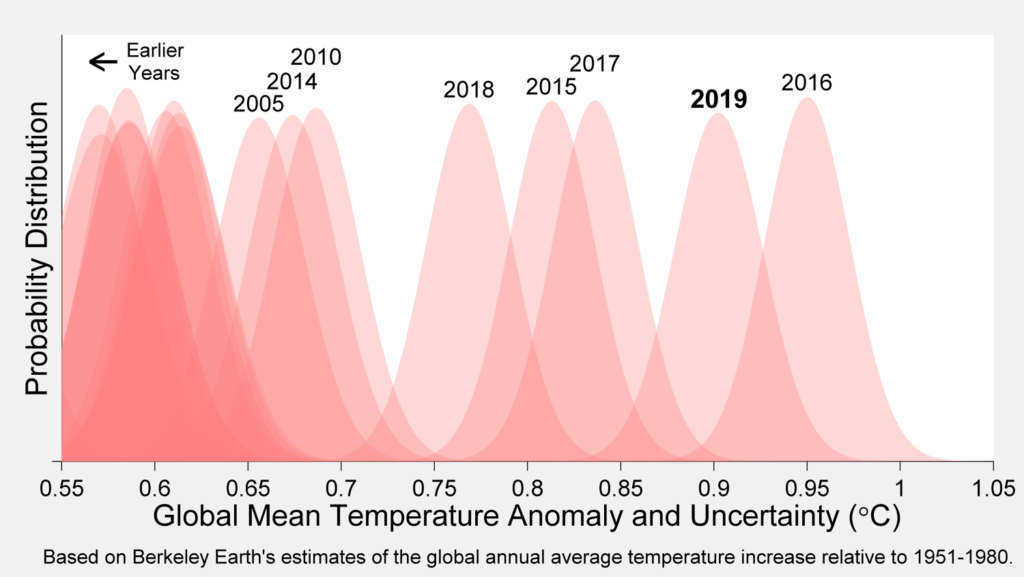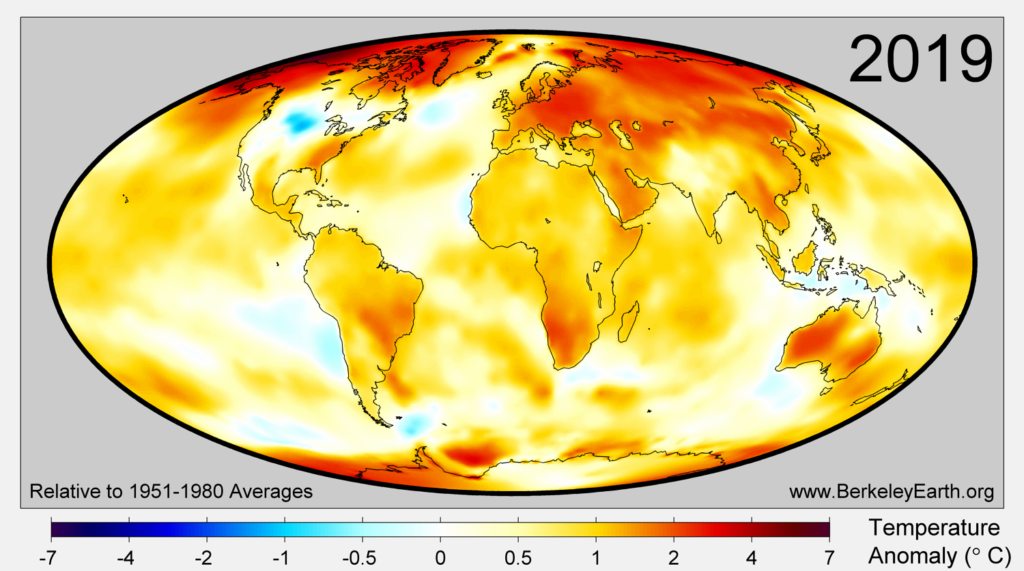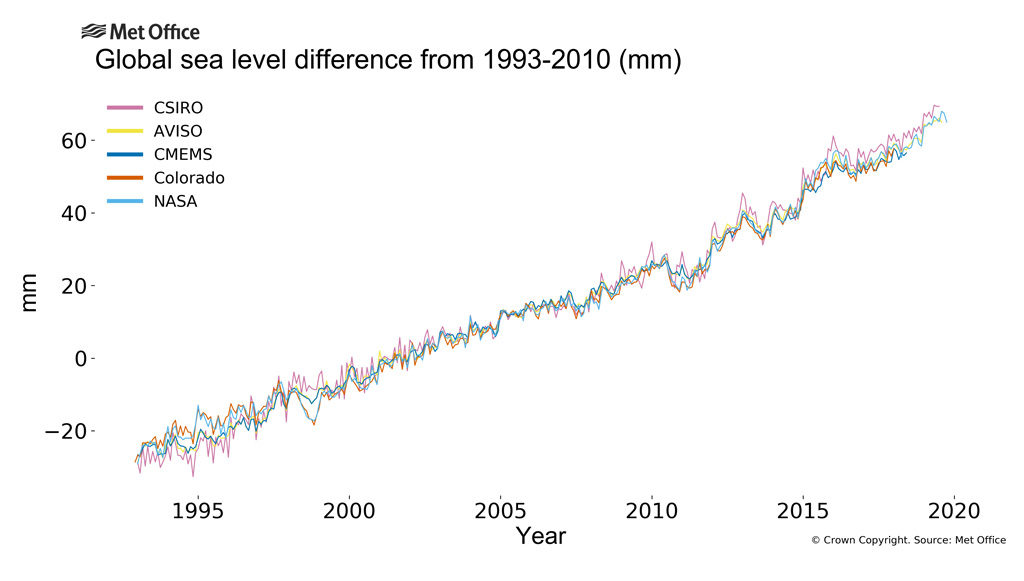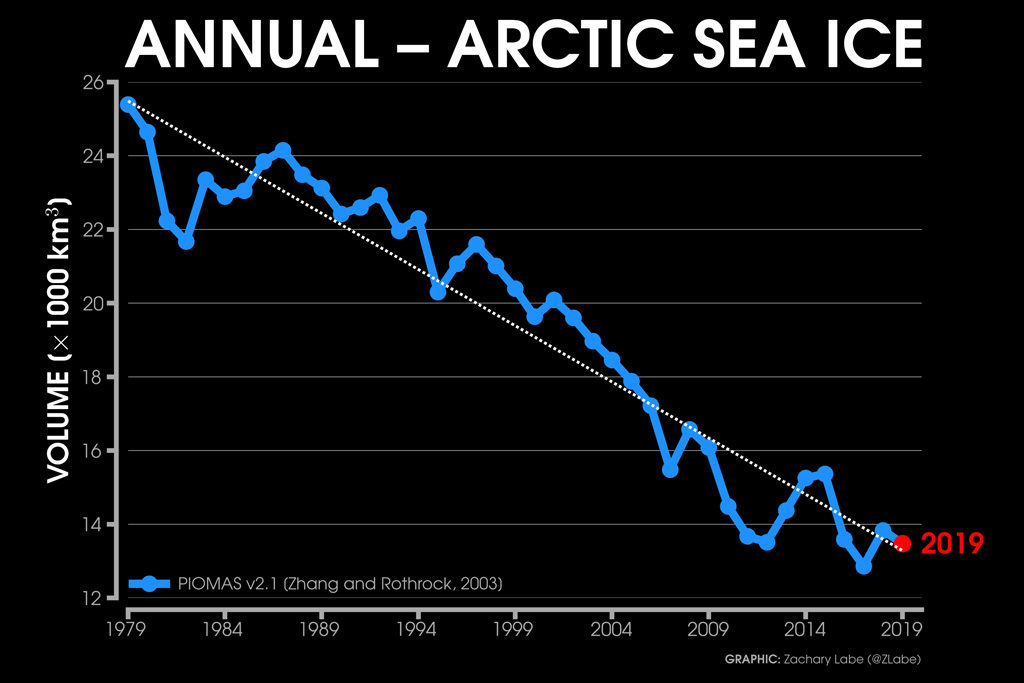
State of the climate: How the world warmed in 2019
Zeke Hausfather
01.20.20Zeke Hausfather
20.01.2020 | 3:45pmAll of the official climate data for 2019 is now in. In this article, Carbon Brief explains why last year proved to be so remarkable across the planet’s oceans, atmosphere, cryosphere and surface temperature.
A number of records for the Earth’s climate were set in 2019:
- It was the second or third warmest year on record for surface temperature – depending on the dataset used – and the warmest year without a major El Niño event. Temperatures in the lower troposphere were also either the second or third warmest.
- It was the warmest year on record for ocean heat content, which increased markedly between 2018 and 2019.
- It saw record lows in sea ice extent and volume in the Arctic and Antarctic for much of the period between April and August. The minimum Arctic sea ice extent reached in September tied for the second lowest on record.
- Global sea levels and atmospheric greenhouse gas concentrations reached new record highs in 2019, while the world’s glaciers continued to melt.
Second warmest surface temperatures
Global surface temperatures in 2019 were the second warmest in most datasets since records began in the late 1800s. Unlike the warmest year – 2016 – El Niño conditions were neutral for most of 2019, with mild El Niño conditions only in the first few months of the year. Temperatures in 2019 were between 1.1C and 1.3C warmer than temperatures in the late 19th century (between 1880 and 1900), depending on the temperature record chosen.
Records from NASA, NOAA, Berkeley Earth, Cowtan and Way, JMA, JRA-55, NCEP and Copernicus ERA5 all showed 2019 as the second warmest year after 2016, while the Met Office Hadley Centre/UEA HadCRUT4 record had 2019 as the third warmest on record. These different ranks reflect differences across the datasets in coverage of the Arctic, which is one of the fastest warming regions of the world.
The figure below shows global surface temperature records from the principal research groups around the world since 1970. These are created by combining ship- and buoy-based measurements of ocean sea surface temperatures with temperature readings of the surface air temperature from weather stations on land. Temperatures are shown as anomalies relative to a 1981 to 2010 average; note that the 1981 to 2010 period is around 0.6 to 0.75C warmer than the 1880-1900 preindustrial period. [Each temperature record can be turned on or off using the figure legend.]
Annual global average surface temperatures from 1970-2019. Data from NASA GISTemp, NOAA GlobalTemp, Hadley/UEA HadCRUT4, Berkeley Earth, Cowtan and Way and Carbon Brief’s raw temperature record. 1979-2000 temperatures from Copernicus ERA5 (as the reanalysis record starts in 1979). Anomalies plotted with respect to a 1981-2010 baseline. Chart by Carbon Brief using Highcharts.The global warming seen is not due to any adjustments made to the underlying temperature records. The figure above includes a “raw records” line (shown as a dotted line) calculated by Carbon Brief using data not subject to any adjustments or corrections for changes in measurement techniques. These adjustments make little difference to the record after 1950. Before then, the adjusted temperature records actually show less warming than the raw data.
Short-term variability in the record is mostly due to the influence of El Niño and La Niña events, which have a short-term warming or cooling impact on the climate. Other dips, such as the one in the mid-1990s, are associated with large volcanic eruptions. The longer-term warming of the climate is entirely driven by atmospheric increases in CO2 and other greenhouse gases emitted from human activity.
Global surface temperature records can be calculated back to 1850, though some groups choose to start their records in 1880 when more data was available. Prior to 1850, records exist for some specific regions, but are not sufficiently widespread to calculate global temperatures with any reasonable accuracy. Global temperature records since 1850 are shown in the figure below, again shown as the difference from a baseline of 1981-2010.
Same as prior figure, but with data extending back to 1850 (or as far back as each individual record is available). Chart by Carbon Brief using Highcharts.The past five years of the record really stand out as much warmer than anything that has come before. This is shown in the figure below from Berkeley Earth. Each shaded curve represents the annual average temperature for that year. The further that curve is to the right, the warmer it was.
The width of each year’s curve reflects the uncertainty in the annual temperature values (caused by factors such as changes in measurement techniques and the fact that some parts of the world have relatively sparse station coverage).

The warmth in 2019 covered large regions of the world, with particularly high temperatures in the Arctic, over Antarctica, Australia, Europe, South Africa, and Siberia. The figure below, from Berkeley Earth, shows the average annual temperature anomalies for the year.

2019 was the hottest year since instrumental records began in the 36 countries: Angola, Australia, Belarus, Belize, Botswana, Bulgaria, Cambodia, Comoros, Djibouti, Gabon, Guatemala, Hungary, Jamaica, Kenya, Laos, Latvia, Lithuania, Madagascar, Mauritius, Moldova, Myanmar, Namibia, Poland, Republic of the Congo, Romania, Serbia, Slovakia, Somalia, South Africa, Taiwan, Thailand, Tuvalu, Ukraine, Vietnam, Yemen and Zimbabwe. In addition, it was also the warmest year on record in Antarctica.
Warming is happening at very different rates over the land and ocean. While the world as a whole has warmed around 1.2C since the pre-industrial era, land regions have seen nearly 1.8C warming, while the oceans have only warmed around 0.8C. The figure below shows land, ocean and global warming relative to the 1880-1900 pre-industrial baseline based on data from NASA.
Land, ocean and global temperature rise since the late 1800s using data from NASA GISTEMP v4. Values are plotted with respect to a 1880-1900 baseline. Chart by Carbon Brief using Highcharts.Observations closely tracking climate modelling projections
Climate models provide physics-based estimates of future warming given different assumptions about future emissions, greenhouse gas concentrations and other climate-influencing factors.
Model estimates of temperatures prior to 2005 are a “hindcast” using known past climate influences, while temperatures projected after 2005 are a “forecast” based on an estimate of how things might change.
The figure below shows the range of individual models forecasts featured in the Intergovernmental Panel on Climate Change (IPCC’s) fifth assessment report – known as CMIP5 models – between 1950 and 2020 with grey shading and the average projection across all the models shown in black. Individual observational temperature records are represented by coloured lines.
Annual global average surface temperatures from CMIP5 models and observations between 1970 and 2020. Models use the RCP4.5 scenario after 2005. They include sea surface temperatures over oceans and surface air temperatures over land to match what is measured by observations. Anomalies plotted with respect to a 1981-2010 baseline. Chart by Carbon Brief using Highcharts.While global temperatures were running a bit below warming projected by climate models between 2005 and 2014, the last few years have been pretty close to the model average. This is particularly true for globally complete temperature records such as NASA, Cowtan and Way, Berkeley and the Copernicus ERA5 reanalysis.
Climate model simulations run from the mid-1800s through to the end of the 21st century. The figure below shows the range of model projections over their full period, using the “stabilisation” scenario for future emissions, known as RCP4.5.
Same as the prior chart, but for the period from 1850-2100. Models use the RCP4.5 scenario after 2005. Chart by Carbon Brief using Highcharts.Warmest year on record in the oceans
More than 90% of the heat trapped by increasing greenhouse gas concentrations ends up going into the Earth’s oceans. While surface temperatures fluctuate a bit from year to year due to natural variability, ocean heat content increases much more smoothly and is, in many ways, a more reliable indicator of the warming of the Earth, albeit one with a shorter historical record.
Last year set a clear record for the highest ocean heat content since reliable records began in 1958, according to the Institute of Atmospheric Physics of the Chinese Academy of Sciences (IAP-CAS), which maintains an up-to-date ocean heat content database.
The figure below shows ocean heat content for each year in the region of the ocean between 0 to 700 metres and 700 to 2,000 metres of depth (comprising the bulk of the world’s oceans). Ocean warming is plotted relative to the 1958-1960 average.
Annual global ocean heat content (in zettajoules – billion trillion joules, or 10^21 joules) for the 0-700 metre and 700-2000 metre layers. Data from Cheng et al 2020. Chart by Carbon Brief using Highcharts.Ocean heat content in 2019 was significantly higher than in 2018, the next warmest year. While 2016 was the warmest year on the surface, it was only the fifth warmest year for ocean heat content, as the El Niño event that helped 2016 surface temperatures be so warm redistributed heat out of the ocean and into the atmosphere. Ocean heat content accelerated notably after 1990, due to an increase in heat being trapped by greenhouse gases and to recovery from the Pinatubo volcanic eruption in 1992, and most years after that have set a new record.
Near-record warmth in satellite records
In addition to surface measurements over the world’s land and oceans, satellite microwave sounding units have been providing estimates of global lower atmospheric temperatures since 1979. These measurements, while subject to some large uncertainties, also show 2019 as a near-record warm year.
The record produced by Remote Sensing Systems (RSS) shows 2019 as the second warmest year after 2016, while the record from the University of Alabama, Huntsville (UAH) shows it as the third warmest after 2016 and 1998. The two records are shown in the figure below – RSS in red and UAH in blue.
Global average lower troposphere temperatures from RSS version 4 (red) and UAH version 6 (blue) relative to a 1981-2010 baseline (as the satellite records begin in 1979). Chart by Carbon Brief using Highcharts.These satellites measure the temperature of the lower troposphere and capture average temperature changes around 5km above the surface. This region of the atmosphere tends to be influenced more strongly by El Niño and La Niña events than the surface and satellite records show correspondingly larger warming or cooling spikes during these events. This is why, for example, 1998 shows up as one of the warmest years in satellites, but not in surface records.
The two lower tropospheric temperature records show large differences after the early 2000s. RSS shows an overall rate of warming quite similar to surface temperature records, while UAH shows considerably slower warming in recent years than has been observed on the surface. Both have seen large adjustments in recent years that have warmed RSS and cooled UAH compared to prior versions of each record.
Sea levels rising faster
Modern-day sea levels have risen to a new high in 2019, due to a combination of melting land ice (such as glaciers and ice sheets), the thermal expansion of water as it warms, and changes in land water storage. In recent years, there have been larger contributions to sea level rise from melting ice sheets and glaciers. According to the 2018 BAMS State of the Climate report, melting glaciers and ice sheets contributed two-thirds of the total sea level rise between 2005 and 2016.
The figure below, from the UK Met Office, shows the increase in global sea level estimate by a number of different groups since the advent of satellite altimeters in the early 1990s.

In addition to the satellite data available since the early 1990s, earlier global sea levels have been reconstructed from a network of global tide gauge measurements. This allows researchers to estimate how sea level has changed since the late 1800s.
Five different sea level rise datasets are shown in the figure below (coloured lines), along with satellite altimeter measurements from NASA (in black) after 1993.
Global mean sea level rise data from Church and White 2011 (red), Jevrejeva et al 2014 (yellow), Ray and Douglas 2011 (grey), Hay et al 2015 (light blue) and Dangendorf et al 2019 (dark blue). Satellite altimeter data from 1993 (black) to present is taken from NASA. Chart by Carbon Brief using Highcharts.Sea levels have risen by between 0.18 and 0.2m (180 to 200mm) since 1900. While sea level rise estimates mostly agree in recent decades, larger divergences are evident before 1980.
Most of these datasets (Dangendorf, Hay, and Church and White) suggest that the current rate of sea level rise – as measured by satellite altimeters – is around 50% faster than was experienced in the 1940s.
There is also evidence of accelerating sea level rise over the post-1993 period when high-quality satellite altimetry data is available. According to the 2018 BAMS State of the Climate report, acceleration in sea level rise during the post-1993 period is around 0.1mm each year. This means that the rate of sea level rise is increasing by 1mm per year each decade. (See Carbon Brief’s explainer on how climate change is accelerating sea level rise.)
Glacier melt accelerating
Scientists measure the mass of glaciers around the world using a variety of remote sensing techniques, as well as through GRACE measurements of the Earth’s gravitational field. The balance between snow falling on a glacier and ice loss through melting or calving determines if glaciers grow or shrink over time.
An international consortium called the World Glacier Monitoring Service tracks 164 different glaciers in 19 different regions around the world. The figure below shows the change in global average glacier mass from 1950 through to the end of 2018 (2019 values are not yet available). Glacier melt is reported in metres of water equivalent, which is a measure of how much mass has been lost on average; 25 metres of melt means that a typical glacier has lost an amount of water equivalent to making the whole glacier 25 metres thinner.
Global average glacier melt from 1950-2018 the World Glacier Monitoring Service in meters of water equivalent. Carbon Brief using Highcharts.Second lowest Arctic sea ice on record
Sea ice spent a sizable portion of 2019 at record lows in both the Arctic and Antarctic. It set daily record lows during most of April, May, July, August and October in the Arctic, and from May through July in the Antarctic.
The Arctic spent much of 2019 well below the historical range over the 1979-2010 period. It tied with 2007 and 2016 as having the second lowest summer minimum sea ice extent since records began in the late 1970s. Only 2012 had lower summer minimum sea ice in the Arctic. The Arctic has experienced an unusually slow sea ice recovery after the September minimum, setting new record lows in October.
Arctic and Antarctic daily sea ice extent from the US National Snow and Ice Data Center. The bold lines show daily 2019 values, the shaded area indicates the two standard deviation range in historical values between 1979 and 2010. The dotted black lines show the record lows for each pole. Chart by Carbon Brief using Highcharts.Sea ice extent only tells part of the story. In addition to declining ice extent, the sea ice that remains tends to be younger and thinner than ice that used to cover the region. The figure below, using data from the Pan-Arctic Ice Ocean Modelling and Assimilation System (PIOMAS), shows the Arctic sea ice thickness for every year between 1979 and 2019. Average 2019 sea ice volume was the second lowest on record, after 2017.

Rising greenhouse gas concentrations
Greenhouse gas concentrations reached a new high in 2019, driven by human emissions from fossil fuels, land use and agriculture.
Three greenhouse gases – CO2, methane (CH4) and nitrous oxide (N2O) – are responsible for the bulk of additional heat trapped by human activities. CO2 is by far the largest factor, accounting for roughly 50% of the increase in “radiative forcing” since the year 1750. Methane accounts for 29%, while nitrous oxide accounts for around 5%. The remaining 16% comes from other factors including carbon monoxide, black carbon and halocarbons, such as CFCs.
Human emissions of greenhouse gases have increased atmospheric concentrations of CO2, methane and nitrous oxide to their highest levels in at least a few million years – if not longer. The figure below shows concentrations of these greenhouse gases – in parts per million (ppm) for CO2 and parts per billion (ppb) for methane and nitrous oxide – from the early 1980s through September 2019 (the most recent data currently available).
Global concentrations of CO2, methane (CH4) and nitrous oxide (N2O). Based on data from NOAA’s Earth Systems Research Laboratory. Note that the y-axes do not start at zero. Chart by Carbon Brief using Highcharts.
